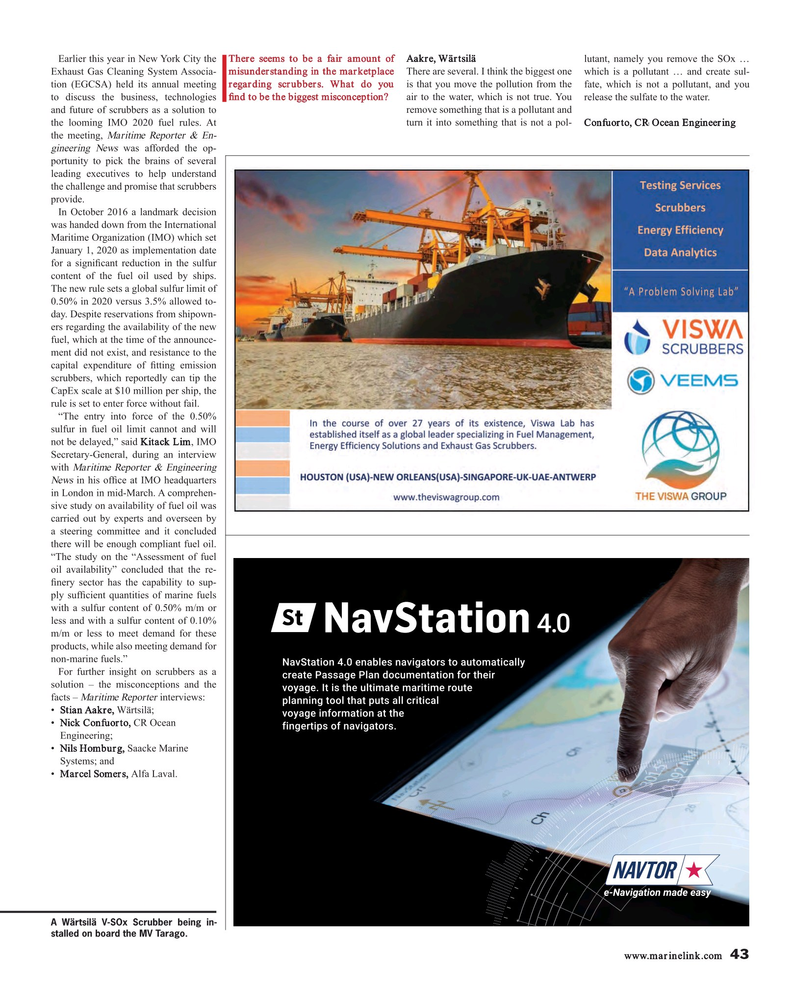
Page 43: of Maritime Reporter Magazine (May 2018)
Marine Propulsion Edition
Read this page in Pdf, Flash or Html5 edition of May 2018 Maritime Reporter Magazine
Earlier this year in New York City the There seems to be a fair amount of Aakre, Wärtsilä lutant, namely you remove the SOx …
Exhaust Gas Cleaning System Associa- misunderstanding in the marketplace There are several. I think the biggest one which is a pollutant … and create sul- tion (EGCSA) held its annual meeting regarding scrubbers. What do you is that you move the pollution from the fate, which is not a pollutant, and you to discuss the business, technologies ? nd to be the biggest misconception? air to the water, which is not true. You release the sulfate to the water.
and future of scrubbers as a solution to remove something that is a pollutant and the looming IMO 2020 fuel rules. At turn it into something that is not a pol- Confuorto, CR Ocean Engineering the meeting, Maritime Reporter & En- gineering News was afforded the op- portunity to pick the brains of several leading executives to help understand the challenge and promise that scrubbers provide.
In October 2016 a landmark decision was handed down from the International
Maritime Organization (IMO) which set
January 1, 2020 as implementation date for a signi? cant reduction in the sulfur content of the fuel oil used by ships.
The new rule sets a global sulfur limit of 0.50% in 2020 versus 3.5% allowed to- day. Despite reservations from shipown- ers regarding the availability of the new fuel, which at the time of the announce- ment did not exist, and resistance to the capital expenditure of ? tting emission scrubbers, which reportedly can tip the
CapEx scale at $10 million per ship, the rule is set to enter force without fail.
“The entry into force of the 0.50% sulfur in fuel oil limit cannot and will not be delayed,” said Kitack Lim, IMO
Secretary-General, during an interview with Maritime Reporter & Engineering
News in his of? ce at IMO headquarters in London in mid-March. A comprehen- sive study on availability of fuel oil was carried out by experts and overseen by a steering committee and it concluded there will be enough compliant fuel oil. “The study on the “Assessment of fuel oil availability” concluded that the re- ? nery sector has the capability to sup- ply suf? cient quantities of marine fuels with a sulfur content of 0.50% m/m or less and with a sulfur content of 0.10% m/m or less to meet demand for these products, while also meeting demand for non-marine fuels.”
For further insight on scrubbers as a solution – the misconceptions and the facts – Maritime Reporter interviews: • Stian Aakre, Wärtsilä; • Nick Confuorto, CR Ocean Engineering; • Nils Homburg, Saacke Marine Systems; and • Marcel Somers, Alfa Laval.
A Wärtsilä V-SOx Scrubber being in- stalled on board the MV Tarago.
www.marinelink.com 43
MR #5 (42-49).indd 43 MR #5 (42-49).indd 43 6/4/2018 8:58:04 AM6/4/2018 8:58:04 AM

 42
42

 44
44
